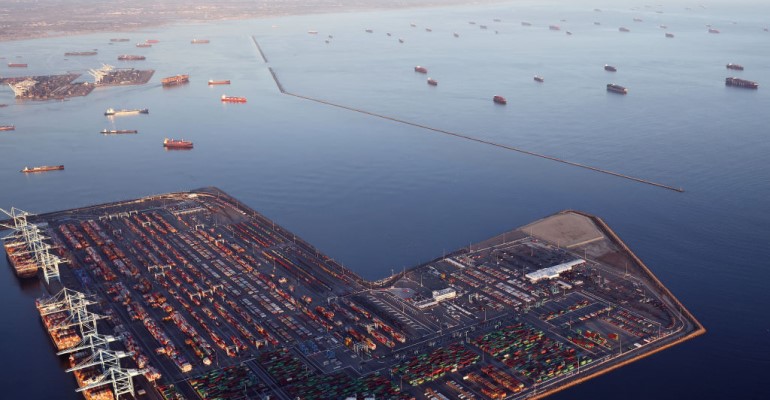As the world’s largest agricultural exporter and looking at a record year in 2021, White House Ports Czar John Porcari says he’s “focused like a laser” on ag exports and knows more can be done to get U.S. ag products around the world.
While U.S. ag exports are at record levels, California’s ports saw a 9% drop in ag containerized shipments and $2.1 billion in lost sales including a 15% drop at the Port of Long Beach, 18% drop at the Port of Los Angeles and 34% drop at the Port of Oakland, historically one of the strongest ports for ag exports.
Mike Durkin, CEO of Leprino Foods which is the largest buyer of U.S. milk and major dairy exporter to 55 countries, says over 90% of his company’s orders have been rolled or missed in 2021, compared to 10% in a normal year. Well over 100 orders rolled 17 times or up to five months. He’s being forced to air freight product just so customers don’t run out of product. And despite reports that issues are starting to clear up, Durkin says December was one of the worst months on record.
Why is this happening?
“It’s all about economics,” explains Porcari. The price of filled exports returning to China is $650 to $1,000, while the price of imports returning is $4,300 to $13,600 which is driving economics against encouraging vessels to fill their boats with U.S. exports.
Earlier in the week USDA and the Port of Oakland announced a short-term solution to help fill empty containers by creating a 25-acre pop up site to load empty containers. Similar efforts helped clear backlogs in Georgia. But just because there’s a pop-up site to have ag containers ready to go, will that actually work to get some reciprocity for U.S. ag exports?
Related: USDA offers solution to ease port disruption
Rep. Dusty Johnson, R-S.D., says pop-up staging areas and investments through the bipartisan Infrastructure and Investment and Jobs Act will be exciting if it works. But he says regulatory reform is what is needed to force ocean carriers to act fairly.
John and Rep. John Garamendi, D-Calif., introduced the Ocean Shipping Reform Act in the House, which overwhelmingly passed overwhelmingly in December in the full House by a vote of 364-60. Reports indicate Sen. Amy Klobuchar, D-Minn., and Sen. John Thune, R-S.D., introduced a companion bill in the Senate.
“IDFA recently announced a Dairy Exports Working Group with the Port of Los Angeles and shipping company CMA CGM to identify and address supply chain issues hindering U.S. dairy product exports. We are hopeful that the Senate will act with urgency to move the Ocean Shipping Reform Act, sending a signal across food and agriculture that a new group of ‘supply chain problem solvers’ has arrived to remove obstacles and invest in long-term solutions that help American agriculture to thrive,” says Michael Dykes, D.V.M., IDFA president and CEO.
Garamendi says he’s been working on maritime issues for 12 years and says the time is now to force ocean carriers to abide by rules if they want to ship in and out of U.S. ports. “Bottomline: all that you’re doing isn’t going to solve the problem.” The problem is ocean reciprocity and requiring a two-way street of products in and out. “Economics drive ocean carriers until there’s a law that says you can’t do it,” he adds.
Johnson explains the interests of ocean carriers, of which only 2% carry U.S. flags, are not well-aligned with the interests of American shippers. The OSRA demands reciprocity, creates minimum services standards and gives the Federal Maritime Commission the tools to enforce the law.The bill places disciplines on ocean carriers’ ability to decline export cargo and when demurrage can be charged, helping to get U.S. exports on the water in a timelier manner.
Related: Ocean shipping reform bill sails to passage
Porcari says it’s clear from current data that ag exports are being disadvantaged right now. “That’s unacceptable.” Shippers could benefit from more transparent data from ocean carriers, which is also part of OSRA.
Durkin says the OSRA offers the ability to try to address the significant imbalance of shipments. “We know carriers are making a lot of money.”
OSRA has widespread support, including from the International Dairy Foods Association, of which Durkin is also a member. He explains solutions are needed for both the short-term and long-term, and this will bring reliability that will roll all the way back to the farmgate. “We need to see an impact in the next six to 12 months. I feel like we’re starting to get some traction. I do think some things can be done on a national level,” Durkin says.
Related: Ocean shipping reform bill looks to turn the tide
At the end of the day, COVID-19 hit, which created a backlog as the U.S. infrastructure already faced its own challenges. “To suddenly solve that issue overnight wasn’t going to happen,” Durkin says. However, he does believe short-term actions with carriers and this administration as well as long-term reform offer hope.
Those in the ag sector have been very vocal about concerns and calling for solutions. Porcari says those in the ag export sector are “punching above its weight” and called on the ag industry to continue to do so to move the needle.
Johnson says the solution is easy. “Pass OSRA. Pass OSRA. Pass OSRA.”


